ARCHIVED - Canadian Nuclear Safety Commission
 This page has been archived.
This page has been archived.
Archived Content
Information identified as archived on the Web is for reference, research or recordkeeping purposes. It has not been altered or updated after the date of archiving. Web pages that are archived on the Web are not subject to the Government of Canada Web Standards. As per the Communications Policy of the Government of Canada, you can request alternate formats on the "Contact Us" page.
2010-11
Report on Plans and Priorities
Canadian Nuclear Safety Commission
The original version was signed by
The Honourable Christian Paradis, P.C., M.P.
Minister of Natural Resources Canada
Table of Contents
Section I - CNSC Overview
Message from the President
- Organizational Priorities
- Planning Summary Table
- Risk Analysis
- Expenditure Profile
- Voted and Statutory Items
Section II - Analysis of Program Activities by Strategic Outcome
- 2.1.1 Program Activity: Regulatory Framework
- 2.1.2 Program Activity: Licensing and Certification
- 2.1.3 Program Activity: Compliance
- 2.1.4 Program Activity: Internal Services
Section III – Supplementary Information
3.1 Supplementary Information Tables
Section I - CNSC Overview
Message from the President
As President of the Canadian Nuclear Safety Commission (CNSC), I am pleased to present this Report on Plans and Priorities. Canadians have benefited from a safe nuclear industry since 1946, supported by effective regulation. Our aim is to continue to oversee the orderly and safe evolution of this sector and its activity.
The recent global economic downturn slowed short-term growth in worldwide and domestic demand for energy. This had an impact on some of the planned new projects by the Canadian nuclear industry that would be regulated by the CNSC. Now, there are promising signs of economic recovery, both here at home and abroad. This recovery, along with long-term energy demand projections, suggests by renewed interest in nuclear energy as a clean energy source in addressing climate change. While the CNSC prepares for tomorrow, it must remain vigilant in keeping Canada's facilities safe today.
The CNSC is entrusted with an important mission: regulating nuclear activities to protect the health, safety and security of Canadians and the environment; and to implement Canada's international commitments on the peaceful use of nuclear energy.
The CNSC regulates all aspects of the Canadian nuclear sector, from mining to energy production, waste management and medical applications. The CNSC is responsible for regulating 22 nuclear power plants, 10 nuclear research facilities, six uranium mines – supplying 25% of the world's supply – and more than 25 legacy and waste sites. The CNSC is also regulating the early stages of some major projects, namely a new nuclear power plant at Darlington and a Deep Geologic Repository in Ontario for low- and intermediate-level waste. It carries out regulatory oversight of more than 3,000 licences in Canada while carrying out over 2,000 inspections and assessing many licence applications, renewals and amendments each year.
The CNSC fulfills its mandate through its dedicated and skilled scientific, technical and corporate specialist staff, responsible for implementing the decisions of the Commission and verifying compliance with licences and regulations; reviewing licence applications and performing environmental assessment review work; and engaging citizens through community outreach activities.
The CNSC is vigilant in regulating the nuclear sector and strives to keep the public informed of progress in its mandate areas of interest to Canadians, such as the National Research Universal reactor and the annual performance of our nuclear power plants and uranium mines. Attention will continue in these areas for the coming year.
In the past year, the CNSC held 11 licensing hearings (including three hearings in communities: Port Hope, Port Elgin, and Saskatoon), and heard from 145 intervenors. These outreach efforts will continue, as the Commission is committed to providing facts and data to mitigate any misinformation and lack of understanding in the general public domain.
On November 20, 2009, the International Atomic Energy Agency released the final report for the Integrated Regulatory Review Service (IRRS) Peer Review of the CNSC in June 2009. The purpose of the IRRS mission was to compare Canada's regulatory practices with international standards and equivalent good practices elsewhere in the world.
Overall, the review team determined that Canada has a mature and well-established nuclear regulatory framework, and that the CNSC does an effective job of protecting the health, safety and security of Canadians and the environment.
We will enhance the way we do business through our continuous improvement initiatives: addressing recommendations from the IRRS mission, strengthening our approach to regulatory research and evaluation, and responding to Management Accountability Framework assessments. By strengthening our internal processes, we will be focusing on key strategies to retain our skilled and knowledgeable staff.
One thing has not changed in the last 64 years: Canada's nuclear regulator will not compromise safety. Canada has an impressive and internationally recognized track record for nuclear safety, and we will continue to strive towards our vision of being the best nuclear regulator in the world, as laid out in this Report on Plans and Priorities.
[ original signed by M. Binder ]
Michael Binder
President
Raison d'être and Responsibilities
In 1946, Parliament passed the Atomic Energy Control Act (AECA), creating the Atomic Energy Control Board and providing it with the power to regulate all nuclear activities related to the development and use of atomic energy in Canada.
Half a century later, in May 2000, the Nuclear Safety and Control Act (NSCA) came into effect and established the Canadian Nuclear Safety Commission (CNSC) as a successor to the Atomic Energy Control Board.
The CNSC is an independent regulatory agency with quasi-judicial powers, has jurisdiction over all nuclear-related activities and substances in Canada.
Our vision
To be the best nuclear regulator in the world.
Our mission
Regulating nuclear activities to protect the health, safety and security of Canadians and the environment, and to implement Canada's international commitments on the peaceful use of nuclear energy.
Our mandate
Under the NSCA, the CNSC achieves its mission through the following areas:
- Regulating the development, production and use of nuclear energy in Canada, as well as the possession and transportation of nuclear substances;
- Implementing measures on the non-proliferation of nuclear weapons and nuclear explosive devices;
- Providing objective scientific, technical and regulatory information about the activities of the CNSC.
In this context, the CNSC:
- Is responsible for complying with the Government of Canada's December 2007 Directive to the Canadian Nuclear Safety Commission Regarding the Health of Canadians. This Directive requires the CNSC, when regulating the production, possession and use of nuclear substances, to take into account the health of those Canadians who, for medical purposes, depend on nuclear substances produced by nuclear reactors;
- Administers the Nuclear Liability Act and, as a Responsible Authority under the Canadian Environmental Assessment Act, carries out Environmental Assessments (EAs) for nuclear projects in accordance with this legislation;
- Is Canada's authority with respect to nuclear safeguards as set out in the Agreement Between the Government of Canada and the International Atomic Energy Agency for the Application of Safeguards in Connection with the Treaty on the Non-Proliferation of Nuclear Weapons.
The Commission has up to seven permanent members, appointed by the Governor in Council, and is supported by 850 employees across Canada. The President of the CNSC is a permanent full-time Commission member, while other members may be appointed to serve full or part-time. Temporary members can also be appointed by the Governor in Council, as required. Commission members are chosen according to their credentials, and are independent of any political, governmental, special interest group or industry influences.
The Commission is a quasi-judicial administrative tribunal and court of record and makes independent, fair and transparent decisions on the licensing of nuclear-related activities, establishes legally binding regulations, and sets regulatory policy direction on matters relating to health, safety, nuclear security and the environment. With respect to licensing matters related to major nuclear facilities, the Commission considers applicant proposals, recommendations of CNSC personnel, and stakeholder views before making its decisions. In order to promote openness and transparency, the Commission conducts its business to the greatest extent possible in public hearings and meetings and, where appropriate, in communities affected by the decision at hand. Commission hearings are conducted in a public forum approximately 10 times per year, and decisions are released within 30 business days after the closing of the hearings.
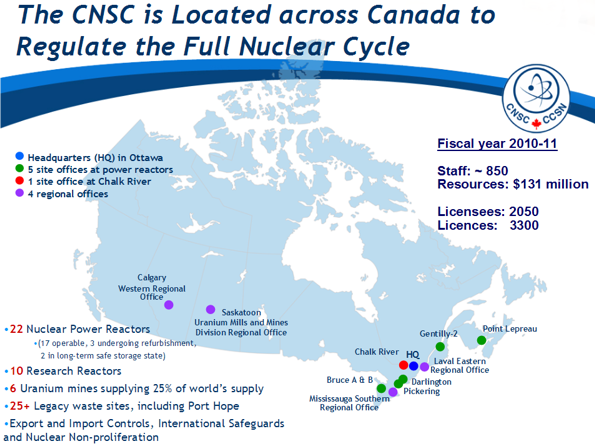
The following organizational chart provides additional details about the CNSC:
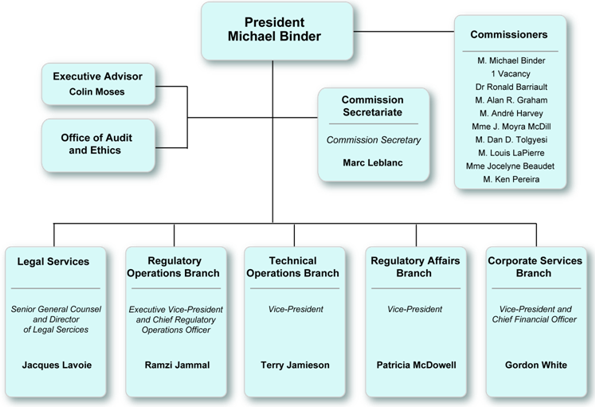
The following chart illustrates the CNSC's complete framework of program activities and program sub-activities, which support its strategic outcome:
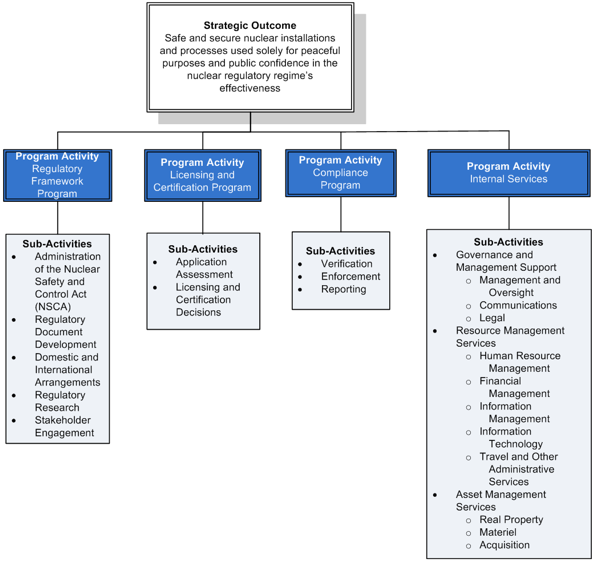
As a regulatory organization with a well-defined mandate, the CNSC's baseline planning work is relatively consistent from year-to-year. However, the CNSC's planning context brings with it mixed drivers and uncertainties to which the organization must respond. The combination of early indications of global and Canadian economic recovery, as well as the Government of Canada's commitment to reducing Canada's total greenhouse gas emissions (goal of having 90% of Canada's electricity provided by non-emitting sources such as hydro, nuclear, clean coal or wind power by 2020) project a scenario where nuclear energy is a critical part of the energy mix.
Based on current circumstances1, the economic crisis halted the continuing short-term rises in the demand for fossil fuels. However, the overall energy demands will resume, and nuclear power is seen as a key contributor in considerations of replacing fossil fuels, as a way to generate electricity and reduce harmful greenhouse gas emissions.
In Canada, although some applications for new nuclear power plants were withdrawn, the CNSC continues to regulate the refurbishment of existing nuclear power plants and prepare for investments in new nuclear power facilities. Any growth in the demand for nuclear energy, at home or abroad, also affects the entire nuclear cycle (from uranium mining and milling, uranium refining and fuel production to long-term management of nuclear waste), thereby driving a demand for more projects in Canada. The CNSC will regulate all of these projects in a simple, clear, and timely fashion in accordance with its mandate.
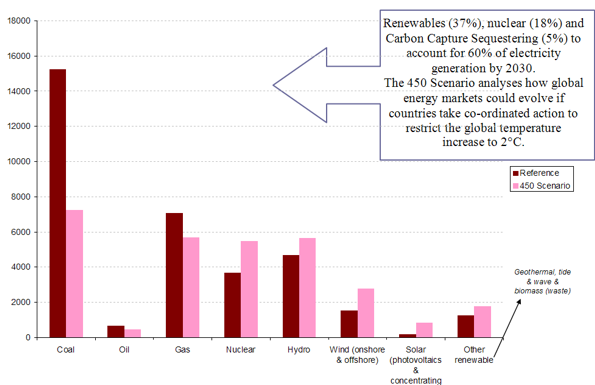
1 International Energy Agency's (IEA) World Energy Outlook 2009 - http://www.worldenergyoutlook.org/
- "As leaders gather in Copenhagen to hammer out a deal on global warming, many nations have seized on uranium and nuclear power as a carbon-free energy solution despite opposition by environmentalists on safety grounds."
- "The case for uranium is bolstered by estimates that electricity demand is due to surge by up to two-thirds by 2030, driven by emerging nations like China and India."
- "A gap of almost 12 trillion kilowatt hours needs to be filled by 2030," said CIBC analyst Ian Parkinson in a research note. "We expect nuclear energy to play a major role in this growth."
Source: http://www.reuters.com/article/idUSTRE5B91PH20091210
The Atomic Energy of Canada Limited's (AECL) National Research Universal (NRU) reactor will remain a key focus for the CNSC. The CNSC will continue its regulatory oversight of AECL, and will be preparing for AECL's licence renewal for the NRU reactor and the rest of the Chalk River Laboratories in 2011.
The CNSC will continue to implement the Directive to the Canadian Nuclear Safety Commission Regarding the Health of Canadians by assigning the highest priority to licensing actions requests which involve patient care issues. Requests from health care providers are acted upon immediately and in most cases approvals, such as for replacements to technetium-99m (Tc-99m), the radioisotope most commonly used in medical imaging, have been authorized in less than one day.
The CNSC has cast its organizational priorities under the heading "Core + Four."
Core regulatory operations represent the bulk of our everyday work to deliver on our mandate. These include the administration of the regulatory framework, licensing, certification, and compliance activities, with the ultimate goal to make sure that the Canadian nuclear industry is operating safely and securely. The Four priorities support and complement our Core regulatory operations:
- Commitment to ongoing improvements;
- Clarity of regulatory requirements;
- Capacity for action;
- Communications.
These priorities and their associated commitments (presented in Section II) support the CNSC's strategic outcome and form the basis of this Report. They are an integral part of the Performance Management Contracts of CNSC executives, our Quarterly Performance Reports, as well as the Departmental Performance Report and Annual Report.
A brief summary of the four priorities follows.
- Commitment to ongoing improvements – "always room for improvements."
In addition to core licensing and compliance activities, this priority includes completing Harmonized Plan initiatives (a continuous series of internal improvement works) and addressing recommendations from the Integrated Regulatory Review Service (IRRS—an international peer review). It also includes ensuring that the health of Canadians and the safety of facilities are central considerations in all licensing and compliance activities through initiatives such as isotope contingency planning and assessing environmental concerns. This priority also encompasses corporate service level and policy improvements, including those identified through various audits.
- Clarity of our requirements – "so everyone understands the rules."
This priority centers on creating broad awareness among licensees, vendors of nuclear technology, and proponents of the CNSC's requirements stemming from the NSCA, whether for refurbishments and life-extensions or new projects (such as design reviews, review guides, joint review panels). Its other goals are revitalizing the CNSC's regulatory framework; updating regulatory documents and guidance, with particular attention to guidance for licence applications and Environmental Assessments (EAs); engaging government partners through the Major Projects Management Office; and continuing the implementation of the protocol for NRU licence renewal.
- Capacity for action – "ready to respond no matter what the situation."
This priority focuses on the CNSC's workforce, to ensure sufficient knowledge and skills in fulfilling our mandate. The CNSC will continue its efforts to brand itself as an Employer of Choice, by shifting from recruitment to retention and training initiatives. We are strengthening our planning and operational processes, and focusing on information management progress in key areas such as compliance reporting, inspection tracking/resolution and financial management.
- Communications – "accurate, clear, concise, and timely."
This priority aims to strengthen communications with the CNSC's licensees, stakeholders, Aboriginal peoples, international counterparts, other government departments and central agencies, in accordance with our goal of being the best nuclear regulator in the world and our mandate to disseminate objective scientific, technical and regulatory information to the public concerning our regulatory activities.
| 2010-11 | 2011-12 | 2012-13 |
|---|---|---|
| 131,422 | 121,438 * | 123,725 * |
The financial resources table above provides a summary of the total planned spending for the Canadian Nuclear Safety Commission for the next three fiscal years.
| 2010-11 | 2011-12 | 2012-13 |
|---|---|---|
| 850 | 795 * | 795 * |
The human resources table above provides a summary of the total planned human resources for the Canadian Nuclear Safety Commission for the next three fiscal years.
* Both total Planned Spending and the associated Planned Human Resources (FTEs) are scheduled to reduce in 2011-12 due to the sunsetting of funding currently allocated for fee-exempt licensees and specific nuclear security activity. Options are being developed for consideration.
The following table summarizes the links between the CNSC's strategic outcome, program activities, expected results and
Government of Canada outcomes. It also includes planned spending by program activity:
| Performance Indicator | Targets |
|---|---|
| Compliance rating of licensees (for each program) | Satisfactory or better in all safety areas |
| Number of radiation exposures over the allowable limits | Zero reported cases |
| Positive International Atomic Energy Agency (IAEA) Safeguards Conclusion | Positive Annual Safeguards Broad Conclusion for Canada |
| Program Activity1 | Expected Results | Forecast Spending ($ thousands) |
Estimated Planned Spending2 ($ thousands) |
Alignment to Government of Canada Outcomes | ||||||
|---|---|---|---|---|---|---|---|---|---|---|
| 2010-11 | 2011-123 | 2012-13 | ||||||||
| 2009-10 | ||||||||||
| Expenditures | FTEs | Expenditures | FTEs | Expenditures | FTEs | Expenditures | FTEs | |||
| Regulatory Framework Program | A clear and pragmatic regulatory framework | 25,946 | 118 | 19,407 | 120 | 16,065 | 102 | 16,100 | 102 | Social Affairs: A Safe and Secure Canada |
| Licensing and Certification Program | Individuals and organizations that operate safely and conform to safeguards and non-proliferation requirements | 27,932 | 211 | 27,709 | 215 | 27,738 | 214 | 28,227 | 214 | |
| Compliance Program | High levels of compliance with the regulatory framework | 38,259 | 267 | 39,868 | 273 | 36,707 | 254 | 37,481 | 254 | |
| Internal Services4 | Activities and resources administered to support the needs of programs and other corporate obligations | 41,792 | 237 | 44,438 | 242 | 40,928 | 225 | 41,917 | 225 | |
| Total Planned Spending | 133,929 | 833 | 131,422 | 850 | 121,438 | 795 | 123,725 | 795 | ||
1 For program activity descriptions, please access the Main Estimates.
2 Most costs incurred for the CNSC's regulatory activities are recovered by the federal government from licensees under the Canadian Nuclear Safety Commission Cost Recovery Fees Regulations(2003). In 2010-11, the CNSC projects to recover approximately $106.3 million in license fees. Of the forecasted $106.3 million to be recovered from licensees, CNSC has authority to directly respend $86.3 million pursuant to Section 29.1(1) of the Financial Administration Act . The remaining $20.0 million is held centrally for costs associated with employee benefits, accommodations, health insurance and other expenditures that are directly paid for by central service providers and reimbursed by the CNSC.
3 In 2006-07 and 2007-08 the Treasury Board approved additional resources for CNSC workload pressures associated with fees-exempt licensees and mitigating risks to nuclear security. Both total Planned Spending and the associated Planned Human Resources (FTEs) are scheduled to reduce in 2011-12 due to the sunsetting of this funding. Options are being developed for consideration.
4 Includes both Internal Services spending and CNSC's capital funding applicable to all Program Activities.
Through our strategic planning exercise the CNSC identified two key risks that could impact our objectives:
Major Project Delays
During the past few years, the CNSC developed and implemented an aggressive recruitment strategy, anticipating increases in the number of major nuclear projects advancing in Canada. The economic downturn in 2008-09 brought uncertainties and delays in the announcements of new nuclear power plants in Ontario. If such projects are seriously delayed or outright cancelled, revenues (which account for approximately 70% of CNSC funding) could be significantly reduced. The CNSC has initiated contingency plans to adapt to these changes without compromising on its regulatory mandate.
Sunset Funding
The CNSC's annual appropriation funding ($45.1 million per Main Estimates) comprises $13.3 million that is due to sunset at the end of 2010-11. This funding supports regulatory oversight of fee-exempt licensees (hospitals, cancer clinics, nuclear research at universities) and sustains nuclear security efforts. The CNSC must ensure continued regulatory oversight of these facilities as well as mitigate risks to nuclear security. Options are being developed for consideration.
The CNSC's operations are funded primarily from fees collected from industry, pursuant to the Canadian Nuclear Safety Commission Cost Recovery Fees Regulations (65-70%), and secondarily through an annual appropriation from Parliament (30-35%).
For the 2010-11 fiscal year, the CNSC plans to spend $131.4 million to meet the expected results of its program activities. Of the $131.4 million in planned spending, the CNSC is requesting $45.1 million in total appropriation funding (annual and statutory Employee Benefit Plans) for CNSC activities related to fee-exempt applicants and licensees (such as hospitals and universities), activities related to international obligations (including safeguards activities in support of the non-proliferation of nuclear weapons), outreach and stakeholder relations activities, public responsibilities (such as emergency preparedness), and the ongoing oversight of the Nuclear Safety and Control Act (NSCA) and the associated regulatory framework.
In addition, the CNSC plans to collect an amount of $106.3 million from fee paying licensees in accordance with the CNSC's Cost Recovery Fees Regulations (2003) for regulatory activities including licensing, compliance and enforcement. Of this $106.3 million, only $86.3 million is respendable by CNSC. The balance is used to offset the costs of services provided by other government departments on behalf of the CNSC.
In 2009, the CNSC conducted a Strategic Review of the funding, relevance and performance of all its program spending to ensure results and value for money. The results of this Strategic Review were submitted to Treasury Board in the fall of 2009, for subsequent review by Cabinet. The results of this Review will be reflected in future reporting to Parliament.
Agency Spending Trend
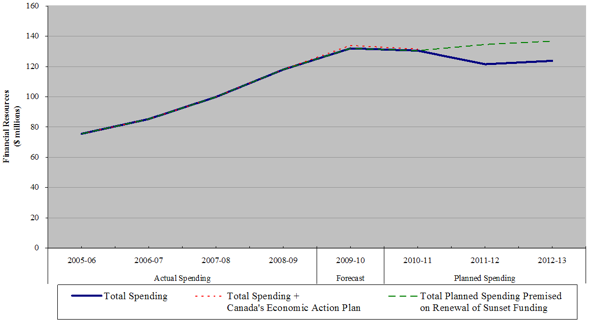
The figure above illustrates the CNSC's spending trend from 2005-06 to 2012-13.
It is important to note that, as of April 1, 2011 (fiscal year 2011-12), $13.3 million in funding from the appropriation to support regulatory activities related to fee-exempt licensees and mitigating risks to nuclear security will sunset. Options are being developed for consideration.
Canada's Economic Action Plan (CEAP)
Through Budget 2009, $250 million was made available to departments and agencies over 2 fiscal years to address deferred maintenance of federal laboratories. The focus was on laboratories that contribute to core regulatory responsibilities of the Government, such as health and safety.
The CNSC was allocated $2 million in 2009-10 and $1 million in 2010-11 for a total of $3 million under CEAP to improve the laboratory capabilities, bringing them up to the international standards. The project core activities include renovation of the laboratory space, purchasing of new equipment, decommissioning of the existing laboratory, and moving to the new laboratory within the National Capital Region.
To respond to the new laboratory program and needs, the CNSC will create new scientific positions in the analytical and calibration fields. Also, in order to meet the organizational laboratory needs, the CNSC will work to obtain the ISO-17025 accreditation (general requirements for the competence of testing and calibration laboratories).
The current CNSC laboratory was established in 1978 as an independent laboratory to perform radio-analytical analyses in support of the inspection regime, as well as to provide radiation detection instrumentation services for the CNSC inspectors. This initiative will significantly strengthen the CNSC's capacity to undertake these activities.
2010-11 CNSC Funding Allocation by Program Activity
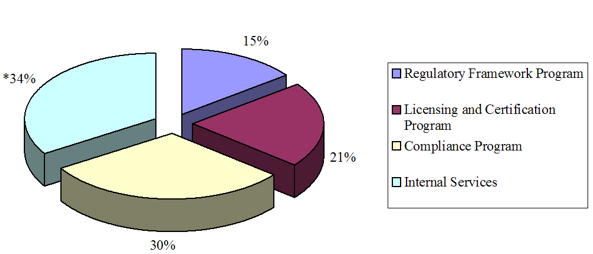
* Includes both Internal Services spending and CNSC's capital funding applicable to all Program Activities.
Details on the expected results associated with these expenditures are provided in Section II: Analysis of Program Activities by Strategic Outcome.
This table illustrates the way in which Parliament approved the CNSC resources, and shows the changes in resources derived
from the supplementary estimates and other authorities, as well as how funds were spent.
| Vote or Statutory Item | Truncated Vote or Statutory Wording | 2010-11 Main Estimates |
2009-10 Main Estimates |
|---|---|---|---|
| 15 | Program expenditures | 40,630 | 40,670 |
| (S) | Expenditures pursuant to paragraph 29.1(1) of the Financial Administration Act | 86,256 | 97,597 |
| (S) | Contributions to employee benefit plans | 4,536 | 4,464 |
| Total Agency (As displayed in the Main Estimates) | 131,422 | 142,731 | |
The CNSC's primary source of funding is derived from the recovery of the full cost of regulatory activities relative to fee-paying licensees pursuant to section 29.1(1) of the Financial Administration Act.
Section II - Analysis of Program Activities by Strategic Outcome
The Canadian Nuclear Safety Commission has a single strategic outcome: safe and secure nuclear installations and processes used solely for peaceful purposes and public confidence in the nuclear regulatory regime's effectiveness. To support this outcome, the CNSC has four program activities: regulatory framework; licensing and certification; compliance; and internal services.
The following section describes the CNSC's program activities and identifies the expected results, performance indicators and targets for each of them. This section also explains planning highlights and benefits for Canadians, and presents the financial and non-financial resources that will be dedicated to each activity.
2.1.1 Program Activity: Regulatory Framework
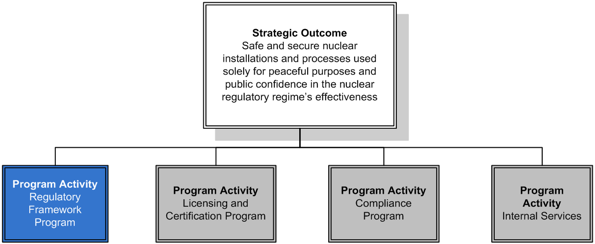
| Human Resources (FTEs) and Planned Spending ($ thousands) | |||||
|---|---|---|---|---|---|
| 2010-11 | 2011-12 | 2012-13 | |||
| FTEs | Planned Spending | FTEs | Planned Spending | FTEs | Planned Spending |
| 120 | 19,407 | 102 | 16,065 | 102 | 16,100 |
| Program Activity Expected Results | Performance Indicators | Targets |
|---|---|---|
| A clear and pragmatic regulatory framework | Satisfaction levels of stakeholders across key performance areas |
Increasing trend in survey results over a three-year period, stable thereafter |
| Number of legal challenges to the regulatory framework | Minimal/declining number of challenges and/or high success rate of defending challenges |
Program Activity Description
The Regulatory Framework program is in place to ensure that Canadians—and licensees, in particular—have a clear and pragmatic regulatory framework for the nuclear industry in Canada.
Funds are used to develop and make amendments to those regulations (such as the Nuclear Safety Control Act and regulations under the Act; regulatory documents, such as policies, standards and guides; the Safeguards Agreement and Additional Protocol between Canada and the International Atomic Energy Agency, and Canada's bilateral Nuclear Cooperation Agreements) that protect the health, safety, security, and environment for Canadians, while implementing Canada's international commitments on the non-proliferation of nuclear weapons.
The CNSC also administers the Nuclear Liability Act and, as a Responsible Authority under the Canadian Environmental Assessment Act, carries out environmental assessments for nuclear projects in accordance with this legislation.
The following table aligns the Regulatory Framework Planning Highlights with their corresponding organizational priorities, and presents the planned timeline for completion.
| Planning Highlights | Timeline for Completion |
|---|---|
| Core regulatory operations | |
| Strengthen management and governance of Regulatory Framework Program | Ongoing |
| Fulfill regulatory oversight to support Canada's obligations on the peaceful use of nuclear materials and technology | Ongoing |
Organizational Priority: Commitment to ongoing improvements |
|
Strengthen regulatory analysis and research to support:
|
March 31, 2011 |
Prepare for new builds
|
March 31, 2011 |
Organizational Priority: Clarity of requirements |
|
Drive regulatory framework priorities
|
March 31, 2011 |
| Review nuclear security, safety, and emergency management policies and procedures post-September 11, 2001. | March 31, 2011 |
| Update environmental and radiation protection under the Nuclear Safety and Control Act. | |
|
September 2010 |
|
March 31, 2011 |
| Consult with Aboriginal communities (First Nations, Métis, Inuit) on the CNSC approach to the licensing and regulatory oversight of nuclear projects, such as nuclear power plants, uranium mines and mills and nuclear waste management facilities, on their Aboriginal rights or title (the duty to consult can be triggered by a variety of CNSC regulatory matters). | 2010-11 |
| Continue to work with its Major Projects Management Office (MPMO) partners to coordinate regulatory activities related to major nuclear projects, including nuclear power plants, uranium mines and mills, and nuclear waste management facilities; share best practices; undertake and integrate policy review initiatives; and advance administrative, regulatory and legislative options to modernize and streamline the federal regulatory system for project reviews - from environmental assessment to licensing. | Ongoing |
Organizational Priority: Communications |
|
| Continue to implement proactive disclosure. | Ongoing |
| The CNSC will explore renewing and updating an existing memorandum of understanding with Health Canada to improve information sharing, analysis, and collaboration. | March 31, 2011 |
Benefits for Canadians
The CNSC maintains an evergreen assessment of the Nuclear Safety and Control Act(NSCA) to fulfill its mandate, and continuously works with other national and international organizations to ensure that nuclear energy and materials are regulated effectively. Through its work with these partners, the CNSC is able to share best practices and lessons learned, and maximize its efficiency.
This program activity also aims to ensure that the CNSC's non-licensee and non-governmental related stakeholders are informed on the activities, policies, programs and the role of the CNSC, and that they have an opportunity to ask questions and express their views. It provides objective scientific and technical information on the areas regulated by the CNSC, and engages stakeholders, by soliciting their input on regulatory issues to enhance the quality of the organization's work and decisions. Licensees and government stakeholders (both domestic and international) are also appropriately informed about, and/or consulted on the role, activities, policies, and programs of the CNSC.
2.1.2 Program Activity: Licensing and Certification
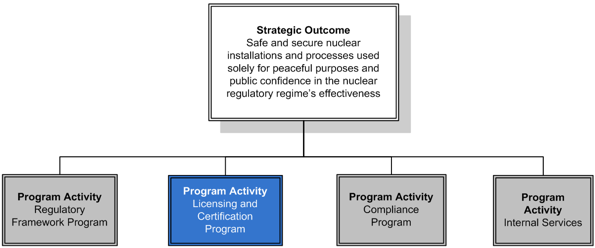
| Human Resources (FTEs) and Planned Spending ($ thousands) | |||||
|---|---|---|---|---|---|
| 2010-11 | 2011-12 | 2012-13 | |||
| FTEs | Planned Spending | FTEs | Planned Spending | FTEs | Planned Spending |
| 215 | 27,709 | 214 | 27,738 | 214 | 28,227 |
| Program Activity Expected Results | Performance Indicators | Targets |
|---|---|---|
Individuals and organizations that operate safely and conform to safeguards and non-proliferation requirements |
Number of licences and certificates issued as per service standards | Meet external performance service standards |
Program Activity Description
The Licensing and Certification program is in place to issue licences or certify persons or organizations to conduct nuclear-related activities in Canada.
With this program activity's funding, the CNSC obtains evidence of the applicant licensees' ability to operate safely and comply with nuclear safeguards and non-proliferation requirements.
The CNSC undertakes this work to obtain assurance that nuclear activities and facilities in Canada are conducted with adequate provision for protection of health, safety, security and the environment and the fulfillment of commitments to the peaceful use of nuclear energy.
The following table aligns the Licensing and Certification Planning Highlights with their corresponding organizational priorities, and presents the planned timeline for completion.
| Planning Highlights | Timeline for Completion |
|---|---|
| Core regulatory operations | |
| Undertake licensing and certification work. | Ongoing |
| Conduct licensing hearings. | |
|
June 30, 2010 |
|
December 31, 2010 |
| Undertake regulatory oversight of Pickering B life extension activities. | Ongoing |
| Undertake regulatory oversight of return-to-service of Bruce A Units 3 and 4 following refurbishment. | Ongoing |
| Undertake regulatory oversight of preparations for refurbishment of Bruce B Units 3 and 4. | Ongoing |
| Develop a relicensing strategy for the refurbishment of all Darlington Units. | Ongoing |
| Undertake regulatory oversight of commissioning activities for design modification/upgrades and return-to-service following refurbishment of Point Lepreau. | Ongoing |
| Execute project plans for new uranium mine applications. | March 31, 2011 |
| Execute project plans for the Darlington Joint Review Panel | |
|
March 31, 2011 |
| Start execution of project plan for Ontario Power Generation's Deep Geologic Repository. | March 31, 2011 |
| Port Hope Area Initiative | |
| Port Hope Project | |
|
2010 |
|
March 31, 2011 |
| Port Granby Project | |
|
March 31, 2011 |
| Organizational Priority: Commitment to ongoing improvements "Always room for improvements" |
|
| Prepare for new builds | |
|
March 31, 2011 |
| Develop and implement policy on the applications of Periodic Safety Review (PSR) for the ongoing operations of Nuclear Power Plants. | March 31, 2011 |
Organizational Priority: Clarity of requirements |
|
| Clarify and streamline abridged hearing process. | March 31, 2011 |
| NRU re-licensing – continue to implement the protocol for licensing renewal | 2010-11 |
|
July 2010 |
|
October 2010 |
|
November 2010 |
|
January 2011 |
| CNSC will ensure regulatory framework for facilities for isotope production is up-to-date, and provide guidance and assistance to potential proponents submitting applications for isotope production. | March 31, 2011 |
| Licence reform | |
|
March 31, 2011 |
Benefits for Canadians
This program activity is central to meeting the CNSC's mandate, by ensuring that applicants for licenses and certificates fully meet the requirements of the NSCA and related legislation before they are permitted to engage in any activity with a nuclear component.
2.1.3 Program Activity: Compliance
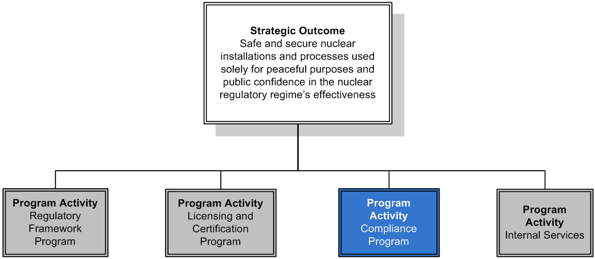
| Human Resources (FTEs) and Planned Spending ($ thousands) | |||||
|---|---|---|---|---|---|
| 2010-11 | 2011-12 | 2012-13 | |||
| FTEs | Planned Spending | FTEs | Planned Spending | FTEs | Planned Spending |
| 273 | 38,868 | 254 | 36,707 | 254 | 37,481 |
Canada's Economic Action Plan (CEAP) |
|||||
| - | 1,000 | ||||
| Program Activity Expected Results | Performance Indicators | Targets |
|---|---|---|
A high level of compliance by licensees with the regulatory framework |
Frequency and severity rate of accidents | Targets set on an annual work planning basis |
| Degree/level of reconciliation between Canada and other countries to nuclear inventories subject to bilateral Nuclear Cooperation Agreements (NCAs) | 100% | |
| Adherence with Sealed Source Tracking requirements | All on time; 100% match with registry. | |
| Nuclear material "ledger" reconciliations between the CNSC and licensees | Identical inventory records on reconciliation of nuclear material. |
Program Activity Description
The Compliance program is in place to ensure that CNSC licensees exhibit a high level of compliance with the CNSC's regulatory framework. This program enables the CNSC to provide regulatory assurance to Canadians of the continuing compliance and safety performance of licensees.
This program activity's funding is used for the promotion of compliance, safety culture and common safety values, compliance audits, inspections, and enforcement actions.
The following table aligns the Compliance Planning Highlights with their corresponding organizational priorities, and presents the planned timeline for completion.
| Planning Highlights | Timeline for Completion |
|---|---|
| Core regulatory operations | |
| Deliver on baseline compliance. | |
|
Ongoing |
Organizational Priority: Commitment to ongoing improvements |
|
| Strengthen the CNSC's inspector training process to ensure the CNSC is prepared to train the next generation of inspectors. | March 31, 2011 |
| Strengthen the CNSC's inspection procedures to ensure there is a consistent approach to inspections of all nuclear facilities and activities. | March 31, 2011 |
| Strengthen integration of operational experience feedback in our compliance activities. | Ongoing |
Organizational Priority: Capacity for action |
|
| Laboratory project – continuous improvement | |
|
March 31, 2011 |
| Update risk-informed compliance approach. | March 31, 2011 |
| Document standard approach to technical assessments. | March 31, 2011 |
Organizational Priority: Communications |
|
| Develop industry report for nuclear substance licensees. | March 31, 2011 |
| Develop industry reports for nuclear cycle and facilities. | March 31, 2011 |
Benefits for Canadians
The CNSC can assure Canadians that its licensees are operating in compliance with their licences, regulations, and underlying legislation, as well as with bilateral Nuclear Cooperation Agreements.
Our Daily Activities
The majority of the CNSC's work involves undertaking licensing and compliance activities in a risk-informed fashion, to ensure that licensees meet regulatory requirements set out in regulations and in their licences. This requires maintaining an adequate level of regulatory vigilance, and being prepared to react according to credible information received.
Much of the compliance work is in the form of inspections of varying types. A Type I inspection is a systematic and documented process to determine, through objective evidence, whether a licensee program, process or practice complies with regulatory requirements; these inspections are similar to an audit or program evaluation. Type II inspections are planned and documented activities to verify the results of licensee processes and not the processes themselves. They are typically routine (item-by-item) inspections and rounds, usually of specified equipment, facility material systems, or of discrete records, products or outputs from licensee processes. A desktop review is the CNSC staff analysis of compliance reports submitted by licensees, with the aim to evaluate if the licensee is complying with the requirements of the regulatory framework.
Typically, in a fiscal year, the CNSC will undertake approximately 100 Type I inspections, 1,800 Type II inspections and numerous desktop reviews.
2.1.4 Program Activity: Internal Services
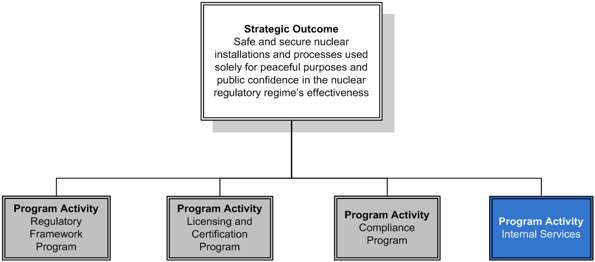
| Human Resources (FTEs) and Planned Spending ($ thousands) | |||||
|---|---|---|---|---|---|
| 2010-11 | 2011-12 | 2012-13 | |||
| FTEs | Planned Spending | FTEs | Planned Spending | FTEs | Planned Spending |
| 242 | 44,438* | 225 | 40,928* | 225 | 41,917* |
* Includes both Internal Services operating funds and CNSC's capital funding applicable to all Program Activities.
| Program Activity Expected Results |
|---|
| Activities and resources administered to support the needs of programs and other corporate obligations. |
Program Activity Description
Internal services are activities and resources to enable and support program delivery and meet other corporate obligations of the Commission, as an agency of government.
These activities are: Management and Oversight (including Audits and Evaluations); Communications; Legal Services; Human Resources Management; Financial Management; Information Management; Information Technology; Real Property and Materiel Acquisition; Travel and Other Administrative Services.
Internal Services include only those activities and resources that apply across the organization and not to those provided specifically to a given program.
The following table aligns the Internal Services Planning Highlights with their corresponding organizational priorities, and presents the planned timeline for completion.
| Planning Highlights | Timeline for Completion |
|---|---|
Organizational Priority: Capacity for action |
|
| Continue improvements to the Revenue Spending Authority Regime by introducing integrated reporting, more critical analyses and simplified costing methods. | Ongoing |
| Re-focus Human Resources activities (from recruitment) to retention and training in line with Employer of Choice efforts, specifically: | |
|
March 31, 2011 |
|
March 31, 2011 |
| Focus Information Management and Technology capacity to deliver on key compliance and tracking deliverables, e-commerce, corporate reporting, and web communications. | March 31, 2011 |
| Establish evaluation function | |
|
March 31, 2011 |
Organizational Priority: Commitment to ongoing improvements |
|
| Continue Service Level and Policy Improvements in support of Harmonized Plan. | March 31, 2011 |
| Develop and enable Management Accountability Framework (MAF) Action Plan in response to Round VII Assessment. | March 31, 2011 |
Benefits for Canadians
The above profile of Internal Services reflects a structure applied across government to support a common government-wide approach to planning, design, budgeting, reporting and communications of government internal services.
The Internal Services enable public programs, as well as other internal services, to operate more efficiently and effectively.
Section III – Supplementary Information
3.1 Supplementary Information Tables
All electronic supplementary information tables found in the 2010-11 RPP can be found on the Treasury Board of Canada Secretariat's Web site.2
- Internal Audits
- Evaluations
- Sources of Respendable and Non-Respendable Revenue
- Green Procurement
2 http://www.tbs-sct.gc.ca/rpp/2010-2011/info/info-eng.asp
The following items of interest are available online.
- Nuclear Power Industry Safety Performance Reports and Report Cards
- External Performance Standards (published in the following CNSC reports):
- Integrated Regulatory Review Service (IRRS)
- Services Received Without Charge
- Details on Transfer Payment Program (TPP)
- The CNSC's Regulatory Plan